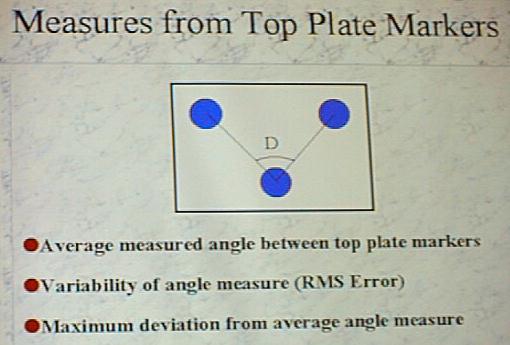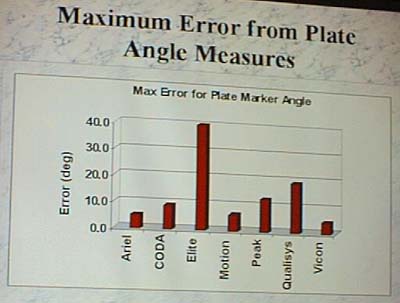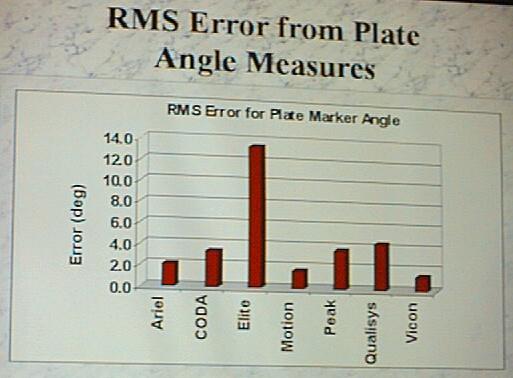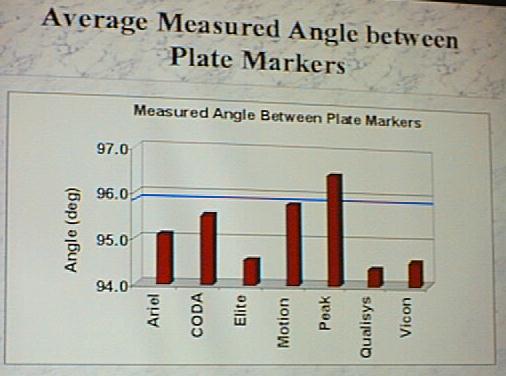
Slide 15. Angle measurement from Top Plate Markers.
(Slide was photographed in the original presentation)

-degrees test95.8
The APAS system utilized a powerful DLT algorithm with a PPT
algorithm, which represent linear and non-linear Direct Linear Transformation.
Therefore, the APAS system was the top performer for this test. Note as
well, that the RMS and the maximum errors recorded were the lowest for the APAS system.
This measurement is probably the most sensitive to errors since 3
markers are involved. Any movement in any of the individual marker will
significantly affect the angle. In addition, these 3 markers were obscured from any
camera at least 50 percent of the time. This means that the power of the DLT was
measured to see how systems can cope with this effect.
The 95.8 degrees test measured the angle between the markers on
the rotating plate. The known angle between the plate markers was 95.8 degrees.
These results are presented in Table 3.
95.8-degrees test Results
| |
Measured |
Rank |
RMS Error |
Rank |
Max Error |
Rank |
Total |
Rank |
Sub-Total |
| |
[deg] |
Score |
[deg] |
Score |
[deg] |
Score |
Error |
Score |
Score |
| Ariel |
95.104 |
4 |
1.215 |
5 |
2.919 |
5 |
4.134 |
5 |
19 |
| Motion |
95.912 |
5 |
1.778 |
3 |
7.010 |
3 |
8.788 |
3 |
14 |
| Peak |
96.500 |
3 |
3.772 |
2 |
12.666 |
2 |
16.438 |
2 |
9 |
| Qualisys |
94.389 |
1 |
4.498 |
1 |
19.256 |
1 |
23.754 |
1 |
4 |
| Vicon |
94.543 |
2 |
1.421 |
4 |
4.632 |
4 |
6.053 |
4 |
14 |
[Go to Home Page] [Top] [Back] [Next Page - Results] .
The APAS system performed fantastically well
when compared to all other companies. When the dollar value of the APAS system
is included in the evaluations criteria, clearly the APAS is in a class by itself. (This
remarkable APAS system, including hardware and software, is available for only $10,000).

Slide 18. Maximum Error from Plate Angle Measures.
(Slide was photographed in the original presentation)

Slide 17. RMS Error from Plate Angle Measures.
(Slide was photographed in the original presentation)
The APAS system performed remarkably well on this test.
This test happened to be very crucial since it had to detect 3 markers on a
rotating plate. This situation would never occur in normal human movement but the APAS
system was amazingly accurate in determine the angle. Other companies produced as
much as 23 degree errors. This measure was particularly useful in demonstrating the
superiority of the APAS system over the other systems. Of particular interest, was
the poor performances by the Peak, Qualisys, and Vicon systems.

Slide 16. Average Measured Angle between Plate Markers.
(Slide was photographed in the original presentation)
The largest error recorded was the Qualisys
with 23.7 degrees and Peak with a 16.4 degree error. If consideration is given to
the switching point problem previously mentioned, this error would increase by an order of
magnitude and raise questions among researchers as to the appropriateness of these
equipment choices for serious research.
Slide 16 illustrates the average measured angle
between the plate markers. The Motion Analysis system measured the average the
closest. The APAS recorded the second closest score. However, when measuring
the maximum error in estimating the angle, the APAS scored the highest with an RMS error
of 1.2 degrees. Although the Motion Analysis system had the best average with 95.1
degrees, the maximum error amounted to more than 7 degrees. The APAS system's
calculated average with 95.1 degrees had as it's maximum error only 2.9 degrees.
When combining the average error with the RMS error, the APAS system scored the best with
4.1 degrees total error with the next equipment being Vicon with 6 degrees.
Table 3. 95.8 Degrees test from the top plate
markers.